Hudson County Courthouse
Introduction
Text-to-speech Audio
Images
Main (east) facade of Hudson County Courthouse in 1979 photo for HABS (Boucher)
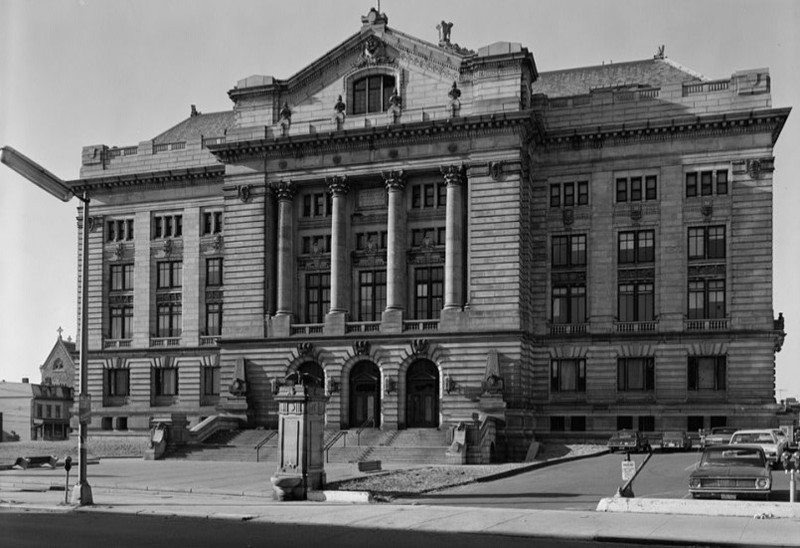
Lion ornamentation on south arm of main entry steps in 1979 photo (Boucher)
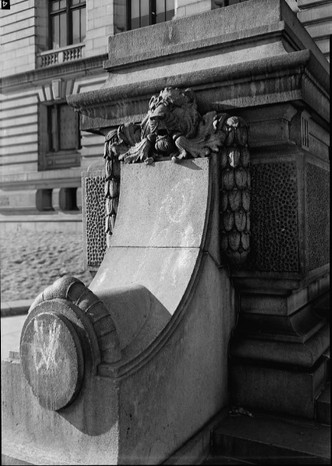
Bronze lanterns flanking main entrance doors; 1953 county building in background (Boucher 1979)
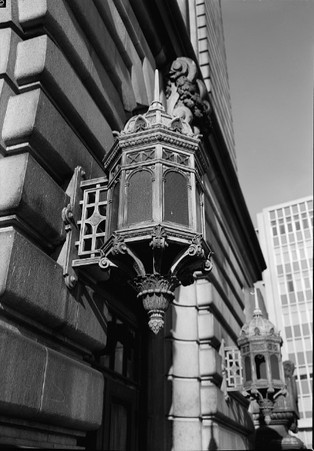
Remaining inscription tablet in recessed main entryway exterior; windows replaced original tablets (Boucher 1979)
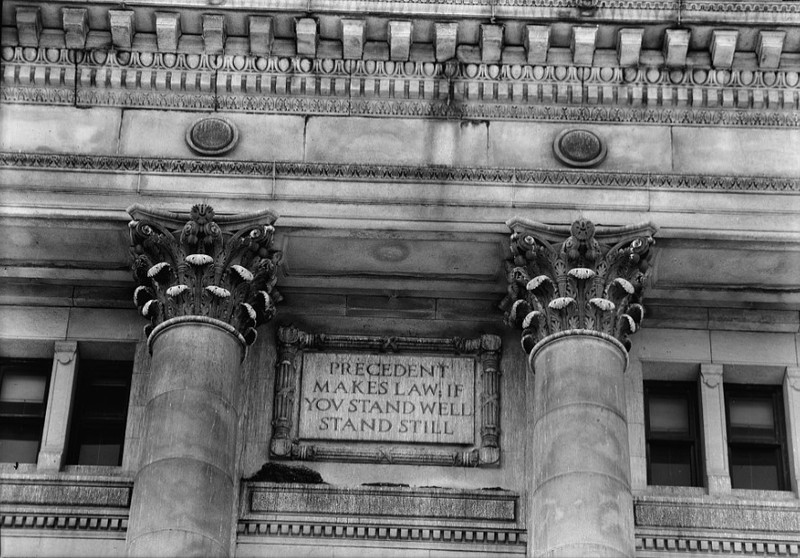
Detail of interior of dome in 1979 photo (Boucher)
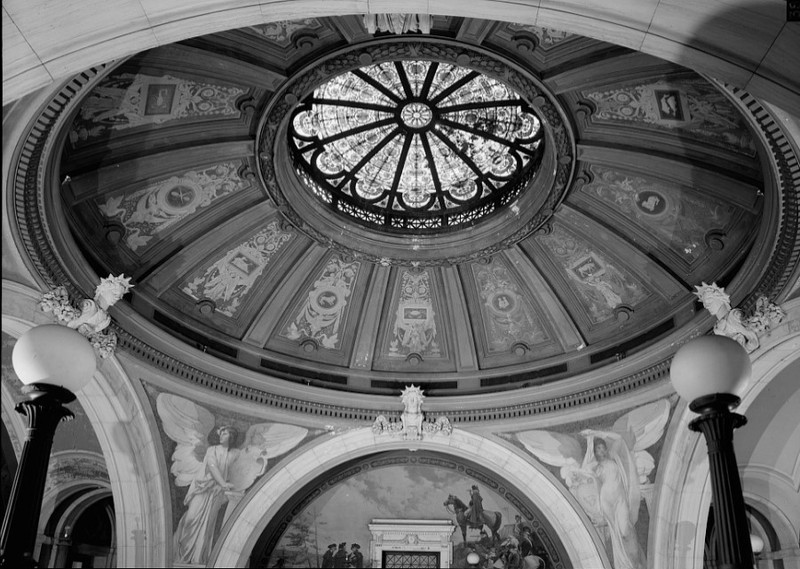
Interior view of rotunda area in 1979 photo (Boucher)
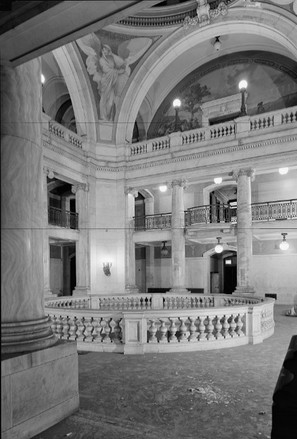
Rooftop cupola, looking northwest, in 1979 photo for HABS (Boucher)

Backstory and Context
Text-to-speech Audio
The first person to practice law in Jersey City was James Wilson, who opened a law office in 1812. Hudson County was formed in 1840; at that time, there were eight lawyers in Jersey City. The new county's first court was held in Lyceum Hall on Grand Street in April 1840, and continued at that location until September 1843. The next spot was the Newkirk House at the Five Corners; the new Court House on Newark Avenue at Hudson City was ready for occupancy by March 1845. The stone building was constructed of rock quarried on the site; a jail was added soon afterwards.
The new courthouse was built next to the existing courthouse on land bought from fourteen landowners of residences standing on the properties. Designed by local Jersey City architect Hugh Roberts and built by Wells Brothers of New York City and John F. Gill & Sons of Cleveland, the groundbreaking was in March 1906 and the cornerstone was laid in December 1906. The grand opening of the six-story building, made of light grey granite quarried in Maine, was on September 20th 1910. Triple doors facing Newark Avenue form the main entrance, reached by wide steps of granite. The top floor of the 183 by 134-foot building contains four courtrooms. Originally budgeted at slightly under $1 million, the final cost was $3.3 million. The bronze window frames and doors, marble interior columns/arches/flooring, and low copper dome were high end details. The dome interior is stained glass, surrounded by images of the signs of the zodiac. Eight columns of green Italian marble in the center of the building, from the second to fourth floors, form an interior space under the dome. Steam heat was supplied to the building from a powerhouse with a brick chimney 125 feet tall. An architectural survey of the vacant building was completed in the 1970s for the Historic American Buildings Survey (HABS).
Below the frieze above the main entrance, there originally were three inscribed stone tablets; two have been removed and replaced with small windows (as seen in one of the photos); the removed tablets read "Justice seeks no praise and bears no blame" and "To delay justice is to deny justice." A number of artists were commissioned to create artwork for the new courthouse. They created impressive painted murals that line the walls of the top floor and basement. The murals tell the story of Hudson County. One is The Coming of the English by Howard Pyle; another two depict Henry Hudson and the purchase of Jersey City, by Frank D. Millet.
The courthouse was renamed in 1988 for Justice William J. Brennan, Jr., a Newark native who served the state's Supreme court from 1949 to 1956 and the U.S. Supreme Court from 1956 to 1990. The courthouse rotunda was named in 2007 for Theodore Conrad, a local architect and the president of the efforts to save the building in the 1970s, under the Citizens Committee to Save the Courthouse. For a time, it was thought that the building might be turned into a cultural and social center under non-county public ownership.
Sources
Boucher, Jack. Hudson County Courthouse, 583 Newark Avenue, Jersey City, Hudson County, New Jersey, HABS No. NJ-841. Historic American Buildings Survey. Washington, DC. National Park Service, 1970.
Conrad, Theodore. NRHP nomination of Hudson County Courthouse, Jersey City. National Register. Washington, DC. National Park Service, 1969.
Eaton, Harriet Phillips. Jersey City and Its Historic Sites. Jersey City, NJ. Woman's Club of Jersey City, 1899.
Fry, Chris. Hudson's Historic Courthouse That Was Almost History, New Jersey Digs. October 3rd 2016. Accessed February 16th 2021. https://jerseydigs.com/william-j-brennan-hudson-county-courthouse-history/.
New Jersey City University. William J. Brennan Hudson County Courthouse, Jersey City Past and Present. July 29th 2020. Accessed February 19th 2021. https://njcu.libguides.com/courthouse2.
New Jersey Judiciary. Hudson County, New Jersey Courts. January 1st 2018. Accessed February 16th 2021. https://www.njcourts.gov/courts/vicinages/hudson.html.
https://www.loc.gov/item/nj0062/
https://www.loc.gov/item/nj0062/
https://www.loc.gov/item/nj0062/
https://www.loc.gov/item/nj0062/
https://www.loc.gov/item/nj0062/
https://www.loc.gov/item/nj0062/
https://www.loc.gov/item/nj0062/
